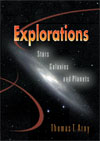It is hard to believe that the stars we see in the night sky as tiny glints
of light are in reality huge, dazzling balls of gas and that many are vastly
larger and brighter than our Sun. They look dim to us only because they are
so far away--several light-years (trillions of miles) to even the nearest. Such
remoteness creates tremendous difficulties for astronomers trying to understand
the nature of stars; direct probing is clearly impossible. In this chapter,
we will see how astronomers overcome the distance barrier that separates us
from stars and how they learn the physical properties of these distant objects.
How far away are they? How big? What are they made of? The answers to these questions show us that most stars are remarkably like
the Sun. For example, like the Sun, they are composed mostly of hydrogen and
helium and have about the same mass. A small percentage, however, are as massive
as 30 times the Sun's mass (30 Msun) and are much hotter than the Sun
and blue in color. Others are much less massive than the Sun, only one-tenth
its mass, and are cool, red, and dim. Moreover, even stars similar to the Sun
in composition and mass may differ enormously from it in their radii and density.
For example, some giant stars have a radius hundreds of times larger than the
Sun's so big that were the Sun their size, it would extend beyond the Earth's
orbit. On the other hand, some stars are white dwarfs, with as much material
as the Sun packed into a volume the size of the Earth. Astronomers can learn all these properties of stars by using physical laws
and theories to interpret measurements made from the Earth. For example, theories
of light yield the surface temperature, distance, and motion of a star; theories
of atoms yield the composition of a star; and a modified form of Kepler's third
law yields the mass of a star. In using such laws, astronomers may sometimes
employ more than one method to determine a desired property of a star. For example,
a star's temperature may be measured from either its color or its spectrum.
Such alternative methods serve as checks on the correctness of the procedures
astronomers use to determine the properties of stars. |



 2002 McGraw-Hill Higher Education
2002 McGraw-Hill Higher Education